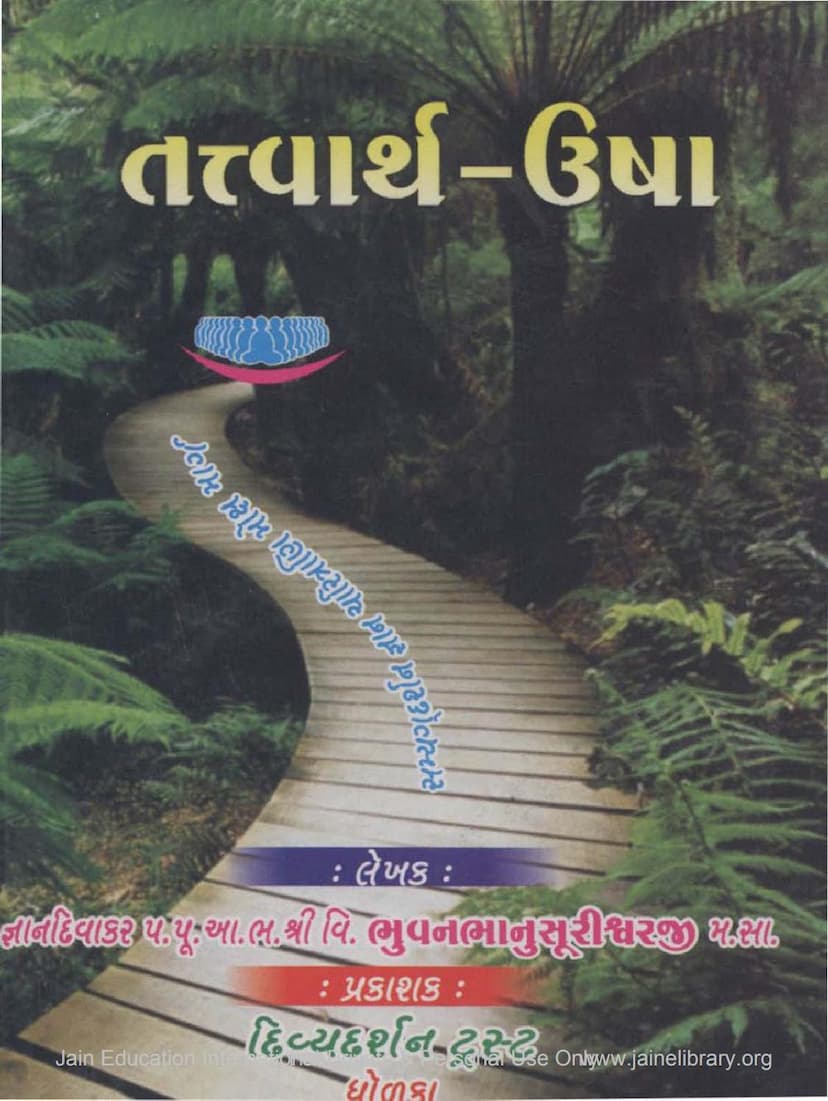Tattvartha Usha
Added to library: September 2, 2025

Summary
Based on the provided pages from "Tattvartha Usha" by Bhuvanbhanusuri, here's a comprehensive summary in English:
Book Title: Tattvartha Usha (તત્ત્વાર્થ-ઉષા) Author: Acharya Vijay Bhuvanbhanusuri (આ.ભ. શ્રી વિ. ભુવનવાજૂરીશ્વરજી) Publisher: Divya Darshan Trust, Dholka Catalog Link: https://jainqq.org/explore/004959/1
Overall Purpose and Context:
"Tattvartha Usha" is a commentary and simplified explanation of the foundational Jain text, the Tattvarthadhigama Sutra (also known as Maha Shastra) authored by Bhagwan Shri Umaswati (Umaswami). The term "Usha" translates to "dawn" or "radiance," suggesting the book aims to illuminate the profound meanings within Umaswati's concise sutras. This particular edition is a re-publication in honor of the birth centenary of Pujya Acharya Bhuvanbhanusuri. It includes the original sutras with simplified explanations, and also incorporates the "Tattvartha Karika" with its meaning as an appendix, making it more comprehensive and useful for students. The book is dedicated to explaining the path to moksha (liberation), emphasizing the fundamental principles of Jainism.
Key Themes and Content:
The book systematically explains the teachings of the Tattvarthadhigama Sutra, which are considered the essence of Jain philosophy. It covers the entire scope of Jain doctrine, from the nature of reality to the path of liberation. Here's a breakdown of the key areas covered, mirroring the structure of the Tattvarthadhigama Sutra:
- The Path to Liberation (Moksha Marga): The introductory sections and the preface highlight that moksha is the pure state of the soul. This state is achieved through Samakit (Right Faith), Samyagjnana (Right Knowledge), and Samyakcharitra (Right Conduct). The book emphasizes that true aspiration for moksha or conduct is only meaningful if it is rooted in Samakit.
- The Nine Tattvas (Nava Tattvas): A significant portion of the book is dedicated to explaining the nine fundamental realities of Jainism:
- Jiva (Soul): Discusses the soul's nature, its various types (based on senses, intellect, consciousness), and its attributes.
- Ajiva (Non-soul): Explains the five categories of non-soul substances: Dharma (medium of motion), Adharma (medium of rest), Akasha (space), Pudgala (matter), and Kala (time). It details their characteristics, regions, and interactions.
- Asrava (Inflow of Karma): Describes the influx of karmic particles into the soul due to the activities of mind, speech, and body, driven by passions.
- Bandha (Bondage): Explains how these karmic particles attach to the soul, obscuring its true nature.
- Samvara (Stoppage of Karma): Details the practices and vows that stop the inflow of new karma, such as the control of senses and passions, adherence to vows, and mindful conduct.
- Nirjara (Shedding of Karma): Explains the process of shedding existing karma through austerities, penance, meditation, and other spiritual practices.
- Moksha (Liberation): Describes the ultimate state of liberation, where all karmas are destroyed, and the soul attains its pure, omniscient, and blissful state.
- Knowledge (Jnana): The book elaborates on the five types of knowledge: Matijnana (sense-based knowledge), ShrutaJnana (scriptural knowledge), Avadhijnana (clairvoyance), Manahparyaya Jnana (telepathy), and Kevala Jnana (omniscience). It differentiates between direct and indirect knowledge.
- Standpoints (Nayas): It explains the different logical standpoints used to understand reality, such as Naigama, Sangraha, Vyavahara, Rujusutra, and Shabda.
- States of the Soul (Bhavas): The book describes the five states of the soul: Oupashamika (suppressed karma), Kshayamika (destroyed karma), Mishr (mixed), Audayika (effective karma), and Parinamic (natural transformation).
- The Universe: It details the structure of the Jain universe, including the different realms (hells, heavens, human realm, animal realm), continents, oceans, and the Meru mountain. It also discusses the lifespans and characteristics of beings in these realms.
- Matter (Pudgala): A significant section is dedicated to Pudgala, its properties, forms (atoms and molecules), combinations, and the results of their interactions.
- Karma: The book provides a detailed account of the eight types of karma (Jnanavarana, Darshanavarana, Vedaniya, Mohaniya, Ayushya, Nama, Gotra, Antaraya), their sub-types, durations, intensity, and the specific actions or states that cause their inflow and bondage. This includes the karmic causes for different states of existence (hell, heaven, human, animal) and specific qualities.
- Vows and Practices: It explains the five main vows (Ahimsa, Satya, Asteya, Brahmacharya, Aparigraha) and the supplementary vows (Guna Vratas and Shiksha Vratas) undertaken by ascetics and lay followers. It also details the associated transgressions (Aticharas) of these vows.
- Austerities (Tapas): The book describes the six types of external austerities and the six types of internal austerities, which are crucial for karma shedding.
- Meditation (Dhyana): It outlines the four types of meditation: Arta (sorrowful), Raudra (fierce), Dharma (righteous), and Shukla (pure/white), and their role in spiritual progress.
- The Soul's Journey: Through the explanations of karma and the path, the book traces the soul's journey through the cycle of birth and death (samsara) and its eventual liberation.
Key Figures Mentioned:
- Bhagwan Shri Umaswati (Umaswami): The revered author of the Tattvarthadhigama Sutra, recognized as a great scholar and compiler of Jain teachings.
- Acharya Vijay Bhuvanbhanusuri: The author of "Tattvartha Usha," who, in his previous incarnation as Muni Bhanuvijay, originally wrote this commentary. He is celebrated as a significant figure in Jainism.
- Acharya Vijay Premasurishwarji: A revered spiritual guide and mentor, mentioned as the inspiration and a guiding light.
- Acharya Vijay Abhayachandrasurishwarji: Another guiding figure whose inspiration is acknowledged.
- Muni Shri Padmavalijee and Muni Shri Hiravijay: Individuals involved in the publication and editing of the book, contributing to its dissemination.
Significance of the Book:
"Tattvartha Usha" serves as a valuable resource for anyone seeking to understand the core principles of Jainism in a clear and accessible manner. By simplifying the intricate sutras of Umaswati, it makes profound philosophical concepts understandable to a wider audience, guiding them towards spiritual enlightenment and the ultimate goal of liberation. The book emphasizes the interconnectedness of knowledge, faith, and conduct as the essential triad for spiritual advancement.